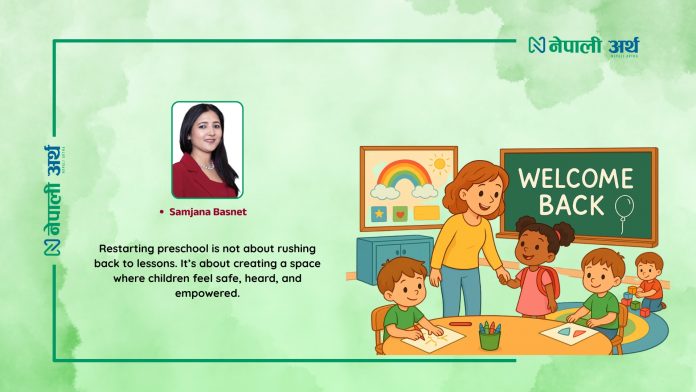- Samjana Basnet
After Nepal’s recent unexpected turmoil, the reopening of kindergartens and preschools is more than just unlocking classroom doors it’s about unlocking hearts. Our youngest learners return not only with curiosity, but also with emotions, questions, and silent stories from their time at home. As teachers, we now hold the delicate but significant responsibility of rebuilding safety, trust, and joyful learning.
Here’s a thoughtful guide to help educators restart Preschool / Montessori / Kindergarten with empathy, creativity, and care:
1. Begin with Special Welcome Rituals
The first moments set the tone. Greet children warmly at the gate or classroom door using a “greeting menu” let them choose between a namaskar, handshake, salute, or fist bump. Sing cheerful songs or host a welcome circle with smiles. Small gestures like giving a “welcome badge” can ease anxiety and spark joy.
2. Make Children Feel Safe and Secure
Children thrive when they feel safe physically and emotionally. Reassure them in simple language:
“School is a safe place. Your teachers are here to care for you. Our routines are made to keep you well.”
Create cozy corners in the classroom where children can retreat for quiet time. Safety isn’t just about walls and gates but it’s about warmth, predictability, and presence.
3. Use Playful Games to Encourage Emotional Expression
Not all children can express their feelings in words. Games like “emotion cards,” feeling dice, or puppet role-play allow children to show how they feel through play. Let expression come before instruction, because healing begins with being heard.
4. Create Space for Group Discussions
Gather children in small circles and ask open-ended questions like:
“What did you enjoy at home?”
“What made you feel happy or worried?”
These conversations build connection and show children they are not alone. Let them share at their own pace some may speak; others may simply listen.
5. Offer Free Play Time with Open-Ended Materials
Free play is therapeutic. Provide materials like blocks, sand, clay, and water items that don’t have fixed outcomes. Let children explore, imagine, and rebuild confidence. Avoid rigid instructions; instead, allow play to flow naturally and reflect their inner world.
6. Plan Drama and Stories on Togetherness
Use props, puppets, or picture books to tell stories about helping each other, being happy together, and sharing. Drama and storytelling help children process emotions and visualize hopeful futures. Let them see themselves in the stories and dream beyond them.
7. Prepare an Art and Expression Corner
Set up a space with crayons, paints, clay, and collage materials. Encourage children to express their feelings through drawings. A silent child may speak through color and shape. Listen carefully not just with ears, but with eyes and heart.
8. Have Individual Conversations with Empathy
Take time to talk one-on-one with each child. Ask gently:
“How are you feeling today?”
“What was your favorite thing at home?”
Practice empathic listening, be fully present physically, mentally, and emotionally.
Remember:
Hearing is healing.
Respond, don’t react.
Acknowledge and validate feelings.
“It sounds like you missed your friends. That must have been hard.”
Use empathetic guesses.
“Maybe you felt worried when things changed suddenly?”
Offer choices to give power back.
“Would you like to draw about it or play with blocks?”
9. Respect Silence and Indirect Expression
Not every child will talk and that’s okay. Do not force expression. Instead:
Listen to their silence.
Observe their play.
Interpret their drawings.
A block tower or a home sketch may carry deep meaning. Respect these non-verbal expressions as valid and valuable.
10. Be Mindful While Listening
When children share, avoid:
Judging (“Don’t feel that way.”)
Advising too quickly (“Just forget it.”)
Investigating (“Tell me exactly what happened.”)
Analyzing or comparing (“Others had it worse.”)
One-upping (“That happened to me too.”)
Shutting down (“Stop crying.”)
Instead, stay gentle and present. Let children lead the pace of their healing.
11. Move from Child-Centered to Child’s-Interest-Centered
Being “child-centered” is not enough. True healing begins when we follow each child’s unique interests whether it’s building, singing, drawing, or storytelling. Let their passions guide your teaching. When children feel seen and heard, resilience and joy naturally return.
Final Thought: Rebuilding with Heart
Restarting preschool is not about rushing back to lessons. It’s about creating a space where children feel safe, heard, and empowered. By weaving empathy, play, and togetherness into daily routines, teachers can help children not only recover but thrive.
Because for children, learning begins with belonging and healing begins with listening.
- (Samjana Basnet is the Principal of Kovida Kids Preschool in Lokanthali, Bhaktapur, and also serves as Secretary of the Association of Preschool Educators Nepal (Central) and General Secretary of the Preschool Olympic Commission.) – Editor


